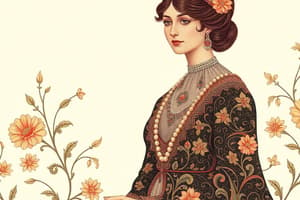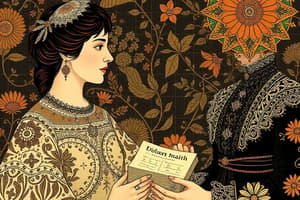Podcast
Questions and Answers
What key action did Susan B. Anthony take on November 5, 1872, in Rochester, New York?
What key action did Susan B. Anthony take on November 5, 1872, in Rochester, New York?
- She organized a rally for women's suffrage.
- She founded a women’s suffrage organization.
- She petitioned the government for women's rights.
- She voted in a presidential election illegally. (correct)
What was Susan B. Anthony's response to her arrest?
What was Susan B. Anthony's response to her arrest?
- She tried to escape.
- She expressed regret for her actions.
- She immediately paid the fine.
- She welcomed the arrest with open hands. (correct)
What was the Susan B. Anthony Amendment proposed in 1878 intended to address?
What was the Susan B. Anthony Amendment proposed in 1878 intended to address?
- Lowering voting age to 18.
- Women's right to vote in all elections. (correct)
- Establishing the federal government’s role in education.
- Abolition of slavery nationwide.
How did Susan B. Anthony view the future of the women's suffrage movement in her later years?
How did Susan B. Anthony view the future of the women's suffrage movement in her later years?
What symbol did Susan B. Anthony associate with perfect equality and the protection of rights?
What symbol did Susan B. Anthony associate with perfect equality and the protection of rights?
What was Susan B. Anthony's first activism cause?
What was Susan B. Anthony's first activism cause?
How did Susan B. Anthony's parents influence her education?
How did Susan B. Anthony's parents influence her education?
What was the pay difference between male and female teachers experienced by Susan B. Anthony?
What was the pay difference between male and female teachers experienced by Susan B. Anthony?
In which region of New York was Susan B. Anthony based during her activism?
In which region of New York was Susan B. Anthony based during her activism?
Why was Susan B. Anthony initially not allowed to speak at temperance rallies?
Why was Susan B. Anthony initially not allowed to speak at temperance rallies?
What nickname was given to Western New York in the early 1800s?
What nickname was given to Western New York in the early 1800s?
Which of the following published a newspaper called The North Star?
Which of the following published a newspaper called The North Star?
Who was the first woman to vote legally in New York State?
Who was the first woman to vote legally in New York State?
What was the relationship between Susan B. Anthony and Elizabeth Cady Stanton?
What was the relationship between Susan B. Anthony and Elizabeth Cady Stanton?
Which publication did Susan B. Anthony and Elizabeth Cady Stanton co-found?
Which publication did Susan B. Anthony and Elizabeth Cady Stanton co-found?
What was one of Susan B. Anthony's concerns about the Fifteenth Amendment?
What was one of Susan B. Anthony's concerns about the Fifteenth Amendment?
What did Susan B. Anthony mean by referring to an 'aristocracy of sex'?
What did Susan B. Anthony mean by referring to an 'aristocracy of sex'?
What was one reason for the split in the suffrage movement?
What was one reason for the split in the suffrage movement?
How did Susan express her hopes for voting rights in her letters?
How did Susan express her hopes for voting rights in her letters?
What was the significance of the phrase 'literary nitroglycerin' used by The New York Times about The Revolution?
What was the significance of the phrase 'literary nitroglycerin' used by The New York Times about The Revolution?
What was stated about the priorities of suffragists related to education levels in voting rights discussions?
What was stated about the priorities of suffragists related to education levels in voting rights discussions?
Flashcards
Who was Susan Brownell Anthony?
Who was Susan Brownell Anthony?
Susan Brownell Anthony was an American social reformer and women's rights activist who played a pivotal role in the women's suffrage movement.
What sparked Susan B. Anthony's activism?
What sparked Susan B. Anthony's activism?
Anthony's early activism stemmed from a teacher who refused to teach her long division because she was a girl. This incident sparked her passion for equality between men and women.
What role did Susan B. Anthony's family play?
What role did Susan B. Anthony's family play?
Anthony's family, being Quakers, strongly believed in equal rights for men and women, influencing her early values and shaping her commitment to social justice.
What was "The Burned-Over District" and why was it important?
What was "The Burned-Over District" and why was it important?
Signup and view all the flashcards
What was significant about Rochester, New York?
What was significant about Rochester, New York?
Signup and view all the flashcards
What was The North Star?
What was The North Star?
Signup and view all the flashcards
What was significant about Seneca Falls, New York?
What was significant about Seneca Falls, New York?
Signup and view all the flashcards
What was the Declaration of Sentiments?
What was the Declaration of Sentiments?
Signup and view all the flashcards
What was Susan B. Anthony's role in the women's suffrage movement?
What was Susan B. Anthony's role in the women's suffrage movement?
Signup and view all the flashcards
What was Florence Chauncey's significance?
What was Florence Chauncey's significance?
Signup and view all the flashcards
Who was Rhoda Palmer?
Who was Rhoda Palmer?
Signup and view all the flashcards
What was Susan B. Anthony's legacy?
What was Susan B. Anthony's legacy?
Signup and view all the flashcards
How did the women's suffrage movement impact women's rights in the US?
How did the women's suffrage movement impact women's rights in the US?
Signup and view all the flashcards
Susan B. Anthony and Elizabeth Cady Stanton's Partnership
Susan B. Anthony and Elizabeth Cady Stanton's Partnership
Signup and view all the flashcards
The Revolution Magazine
The Revolution Magazine
Signup and view all the flashcards
Susan B. Anthony's Passion for Women's Suffrage
Susan B. Anthony's Passion for Women's Suffrage
Signup and view all the flashcards
The Split in the Women's Suffrage Movement
The Split in the Women's Suffrage Movement
Signup and view all the flashcards
Opposition to the Fifteenth Amendment
Opposition to the Fifteenth Amendment
Signup and view all the flashcards
The "Aristocracy of Sex"
The "Aristocracy of Sex"
Signup and view all the flashcards
Susan B. Anthony's Views on Racial Equality
Susan B. Anthony's Views on Racial Equality
Signup and view all the flashcards
Arguments Against Women's Suffrage
Arguments Against Women's Suffrage
Signup and view all the flashcards
How did women's suffrage advocates view the Fifteenth Amendment?
How did women's suffrage advocates view the Fifteenth Amendment?
Signup and view all the flashcards
Why did Susan B. Anthony vote illegally in 1872?
Why did Susan B. Anthony vote illegally in 1872?
Signup and view all the flashcards
How did Susan B. Anthony react to her arrest and trial for voting?
How did Susan B. Anthony react to her arrest and trial for voting?
Signup and view all the flashcards
What was Susan B. Anthony's legacy after her trial?
What was Susan B. Anthony's legacy after her trial?
Signup and view all the flashcards
What was Susan B. Anthony's attitude towards future generations of activists?
What was Susan B. Anthony's attitude towards future generations of activists?
Signup and view all the flashcards
Study Notes
Susan B. Anthony's Life and Activism
- Susan B. Anthony was born in 1820 and died in 1906.
- She was an American social reformer and women's rights activist.
- Initially, she was a teacher and involved in the temperance movement.
- Her activism focused on women's suffrage (right to vote).
- She believed in equal rights for women and men.
- She worked alongside Elizabeth Cady Stanton in advocating for women's rights.
- They published a magazine titled "The Revolution" voicing their views.
- She challenged the status quo, pushing for the amendment to the Constitution granting voting rights to women.
- She was arrested and tried for voting illegally in 1872.
- She was fined for the illegal act but refused to pay it.
- She persisted in her activism for her entire life.
Early Life and Education
- Anthony's teacher discouraged her advanced math studies, highlighting the limited expectations of girls.
- Quaker upbringing fostered the belief in equal ability between genders.
- She was home-schooled and attended Quaker schools.
- Her family was significantly impacted by economic hardship.
- Her father owned a cotton mill, and lost the business during a recession.
- The family became innkeepers during this time.
Activism and Reform
- She participated in the temperance movement to ban alcohol sales.
- She was denied speaking opportunities at rallies because of her gender.
- She refused to accept this disparity, vowing to achieve equality.
- She took on a teaching role but resigned because of pay inequality.
- She sought out multiple means of earning money and helping her family.
- She worked to gain support for women's rights, and equal pay for equal work.
Key Events and Accomplishments
- Met Elizabeth Cady Stanton in 1851, forming a lasting partnership.
- They founded the women's rights newspaper "The Revolution" in 1868.
- They advocated for women's suffrage through speeches and publications.
- She illegally voted in 1872, leading to her trial and conviction.
- Continued activism for women's rights throughout her life.
- She supported the 15th amendment that granted Black men the right to vote.
- She argued for women's suffrage on equal footing with Black men.
- At a time when many people thought women could not handle advanced math.
Studying That Suits You
Use AI to generate personalized quizzes and flashcards to suit your learning preferences.




